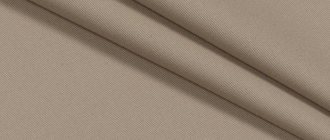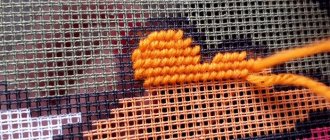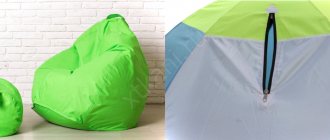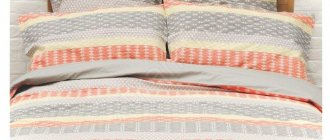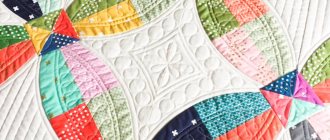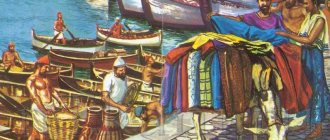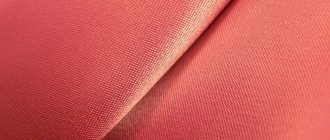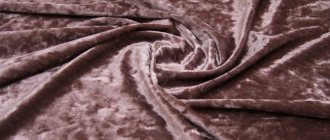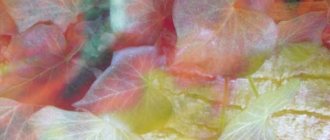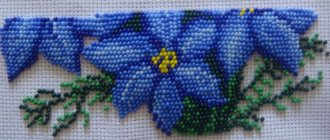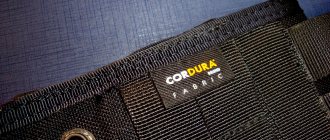Weaving weaves
WEAVINGS
If you pick up a magnifying glass and carefully examine the fabric, you can see how the threads are intertwined. In some fabrics (gauze) this can be seen without a magnifying glass. Yarn is used to make threads. It is obtained from fibers. Even in ancient times, people knew how to connect individual thin, short fibers into long threads. At first it was the fibers of wild plants - hemp and nettles, then - animal wool, and then - the fibers of cultivated plants - flax and cotton.
Fiber
- a thin unspun thread. It comes in different lengths, shapes and thicknesses. The fibers from which yarn, threads, and fabrics are made are called textile.
For many hundreds of years, people made yarn by hand: they pulled a thin ribbon from a mass of fibers with their fingers and twisted it. Then they began to produce yarn using hand spindles.
The process of making fabric from yarn is called weaving. Fabric is made on looms operated by weavers. The fabric is obtained by weaving threads.
BASE FABRIC
- a longitudinal system of threads in fabric. In the process of weaving it on a loom with threads of another weft system, a textile fabric is formed.
Weaving not only gives fabrics a different appearance, but also changes their properties. So, the more often the threads are intertwined, moving from the front side to the back side and back, the more they are connected to each other, the more stressed, the structure of the fabric is stiffer, and the strength is greater. Threads with frequent bends give the surface of the fabric a matte appearance, while long overlaps passing over several threads make it smooth and shiny. Fabrics whose surface is formed by long overlaps are more resistant to abrasion, but threads that are weaker in the overall structure of the fabric fray more easily along its cut.
Fabric structure
The fabric is a spatial mesh of rectangular or square cells formed by two mutually perpendicular systems of threads - warp threads located along the fabric and weft threads lying across the fabric. The different sequences of weaving the warp and weft threads in fabrics create various patterns - the warp and weft threads go around one another or overlap several threads at once, located either on the front or on the wrong side of the fabric.
Fabric finishing
The fabric that is removed from the looms is called harsh or harsh.
It has a rough surface. The color of the fabric corresponds to the color of the fibers from which it is made (linen - grayish, cotton - yellowish).
Fabric finishing
Raw fabric is subjected to finishing in order to improve the quality and properties, giving the fabric a marketable appearance.
Stages:
- pre-finishing (cleaning and preparing fabric);
- whitening;
- coloring;
- drawing;
- final finishing.
Fabric that has been finished is called finished. Depending on the finishing method, various types of fabrics are obtained
- Rapport is a repeating part of a pattern on fabric.
- There is rapport by warp - Ro and rapport by weft - Ry
- Shift is a number indicating how many threads are removed from the overlap of the next thread from the previous one.
Weave weave
Weaving is the interweaving of warp and weft threads. There are different types of weaves. The appearance of the fabric and its properties depend on the type of weave. The simplest and most common weaving technique is plain weave. In it, the threads intersect through one another: the weft thread passes alternately above and below the warp thread. This way, the weaving pattern is the same on both sides of the fabric.
Weave fabrics
All weavings are divided into four classes:
- simple (smooth) weaves, giving the fabric a smooth, uniform surface;
- finely patterned weaves with patterns of small figures formed by modification, complication and combination of smooth weave;
- complex weaves formed from several systems of warp and weft threads;
- large-patterned weaves that form a variety of large patterns on the fabric;
In simple large-patterned weaves, patterns are created by one warp and one weft, in complex ones - not by systems of warp and weft threads.
TYPES OF SIMPLE WEAVES
PLAIN WEAVE
PLAIN WEAVE
- weaving, in which there is a strict alternation of warp and weft threads in a 1:1 ratio. Moreover, if the first warp thread has reached the surface, then the second is covered with a weft thread, etc. This strict alternation occurs along the entire length and width of the fabric. This produces material that is the same on both sides.
TWILL OR DIAGONAL WEAVE
TWILL OR DIAGONAL WEAVE
- one in which each weft thread in relation to the warp thread in each next row is shifted one move to the right or left. The intersections of the threads form diagonal stripes on the surface of the fabric at an angle of 45 degrees. If the wefts are moved to the right, you get a knit twill, if you move to the left, you get a purl twill.
SATIN WEAVE
SATIN WEAVE
- a weave in which at least five warp threads cover the weft, which comes to the surface above only one warp thread.
Such an atlas is called the main one. If at least five weft threads cover the warp in such a way that only one warp thread appears on the surface of the fabric, it is a weft satin.
Properties of fabrics
Signs of identifying the front and back sides of fabric
The finished fabric has two sides - front and back, the same width along the entire length of the fabric.
To the next lesson:
- "Iris" threads, 2 colors
- thick cardboard
- Ruler, pencil, scissors
Types of materials and their applications
Fabrics with a satin weave are called satin. Initially, the material was made from silk. Today, the raw materials can be both natural and artificial and synthetic fibers.
Several examples of satin fabrics, their properties and applications:
- Fabrics such as crepe satin are made from silk yarn. The textile is based on raw silk threads, and the weft is made from crepe silk (with a very strong twist). These are expensive materials. On the front side, crepe satin is shiny and grainy, on the back side it is matte and smooth. The fabric is pleasant to the body. It is used for sewing delicate items: evening dresses, blouses, suits for celebrations. An interesting property of crepe satin is that both sides of the fabric can be used for clothing.
- Based on cotton fibers, fabrics are made that are close to silk in smoothness, but at the same time are much cheaper. Cotton sateen is light and soft, it is often used for sewing bedding sets. Fabrics can be plain-dyed or printed. Properties of cotton sateen: strength, resistance to frequent washing, hygroscopicity, pleasant cooling effect.
- Wool is used to produce expensive thin and dense fabric - drape-satin. It is very warm, does not wrinkle, protects from the wind, and fits the figure beautifully. Used for sewing outerwear.
- Satin-woven polyester has a silk-like appearance. It is just as smooth and shiny, but the properties of synthetic material are not as good. It becomes electrified, slips a lot, and wrinkles. The skin in such fabric practically does not breathe. The advantage of polyester fabrics is their low cost.
- Blended fabrics are made from polyester and cotton fibers, for example, polysatin. Curtains, tablecloths, bedspreads, bathrobes and other home textiles are made from canvas. Polysatin with a predominance of synthetic threads can cause irritation and roll up.
Properties
Fabrics produced in this way have many advantages:
- strength and durability. With proper care, they are quite wear-resistant and do not lose their original appearance for a long time;
- hygroscopicity (natural varieties);
- breathability. Allow the skin to breathe;
- softness. Very pleasant to the body, do not cause irritation, therefore they are often used as a lining;
- opacity. Even the thinnest satin and satin transmit little light, so they are widely used for sewing curtains;
- have the ability to drape. They form beautiful folds, flow softly and shimmer, reflecting light;
- are not electrified. Natural silk and cotton do not accumulate static electricity;
- do not shrink after washing.
Also, a certain percentage of elastic threads (elastane, lycra, spandex) can be added to silk and cotton, which give the material stretchability. The percentage of elastane can be from 1 to 30. Usually it is added to both the weft and the warp, then the result is a fabric that stretches in length and width (bi-stretch). If elastane is added only to the warp or weft, then the fabric will stretch either lengthwise or crosswise (mono-stretch).
Peculiarities
_tkani-1
tkani-2
The warp threads, running parallel to each other along the fabric, at a significant interval fall under the weft thread (it runs perpendicular to the warp), that is, they predominate. Usually in a satin weave there are four or more warp threads overlapping one weft thread. Due to this, the density of the threads becomes high, and the front side becomes smooth, shiny and sliding, and, consequently, the wear resistance and durability of the product made from such fabric increases.
Satin is often confused with satin, and all because the type of weave in satin is the same, with the difference that on the front surface the weft threads predominate over the warp threads.
The raw materials for satin fabrics are silk and semi-silk; for the production of satin, twisted cotton or synthetic fibers are usually used. The more twist the cotton threads have, the more shiny the fabric.
atlasnoe-weave
satin-weave
Where does matter occur?
The satin is suitable for sewing simple items of clothing. At the same time, shiny material is used to create delicate, festive outfits. What products are made from satin weave fabrics:
- women's blouses, dresses, skirts;
- men's shirts, trousers, suits;
- popular wedding dresses;
- ties, scarves and other accessories;
- bed sheets;
- underwear;
- curtains, curtains, tablecloths;
- dance shoes;
- lining for outerwear;
- various decorative and finishing elements: ribbons, bows;
- upholstery of luxury furniture;
- theatrical props and much more.
Production history
The first satin fabrics appeared in China more than two thousand years ago. They were made from silk raw materials; the technology was kept secret for many centuries. The popularity of the material grew, it spread throughout South Asia, then to Ancient Greece. In the Middle Ages, the atlas became famous in Europe.
Since the raw material (natural silk) was very expensive, expensive clothes were made from satin for emperors, clergy and monarchs. Only closer to the middle of the 20th century, when synthetic fiber appeared, did it become available to everyone. Now women's evening dresses, blouses, dresses, and home textiles are made from satin.
Read about: viscose: main characteristics.
Silk satin also began to be woven in China, in the 12th century. And in 1890, a satin weave material made from cotton fiber was patented. Cotton is first subjected to a mercerization process: it is dipped in a solution of alkali and acid in turn. This makes it more durable and shiny, and the additional satin shine of cotton sateen is given by the twist of the threads: the more tightly they are twisted, the more shiny the material will be and the more it will weigh. It is used primarily for the production of bed linen, home textiles and summer clothing.
Colored paper rug: woven
This activity on weaving strips of paper teaches a child to work with scissors, helps develop creative imagination, eye, attention, aesthetic taste, and independence. And also in the process, fine motor skills of the hands develop and responsibility for one’s work is developed.
A paper mat can be offered to children 6-7 years old.
Before starting classes, adults should prepare and make a model on which the child will rely.
For the rug you will need:
Fabric examples
These fabrics with satin weave are the most common:
- Crepe satin is a shiny silk fabric with a twisted weft thread.
- Satin-satin is a fabric based on silk and cotton, shiny on the front side and matte on the back.
- Stretch satin - silk with lycra fibers included. Elastic, wrinkle-resistant fabric.
- Russian satin is a fine weave made from raw silk threads.
Russian atlas (thick)
Review of pros and cons
List of positive qualities of satin weave fabrics:
- First of all, such materials are very beautiful, their shine and color saturation are preserved after long use.
- These fabrics are soft, very comfortable to wear, and have a cooling effect.
- The satin remains durable for a long time.
- Natural material allows air to pass through well.
- The fabric does not cause allergic reactions.
- Natural fibers in the material guarantee the absence of electrification.
- The material drapes well and fits the figure beautifully.
- Even thin canvases are opaque and do not transmit light well. This allows you to sew from them dense and at the same time airy dresses, curtains, etc.
Multi-colored satin fabrics
with this weave are worth noting :
- Shrinkage is possible after washing;
- delicate silk fabrics require careful care;
- voluminous products are quite heavy;
- the raw edge of the satin crumbles, the fabric slips - this complicates cutting.
Relief drawings
Depending on the different ratio of protruding weft and warp. This is how 3 popular groups of weaving are formed:
- Waffle;
- Diagonal;
- Rubchikovoe.
To create relief, an extension of the floor is used. The pattern is formed diagonally thanks to a rib with an angular direction. Its convexity depends on the selected shift and its warp thread thickness.
Scar diagonals are often arranged in pairs in each report. They can be directed either at an angle or strictly vertically, which creates a pseudo dive.
The elongated overlaps are responsible for creating a gap in the waffle weave. The threads pull together long gaps, forming individual wafer groups. The gaps are made thanks to the linen type. Since they are less dense, they are better translucent, which creates that same cellular relief. These types can also be combined with each other, which gives them a special shape.
